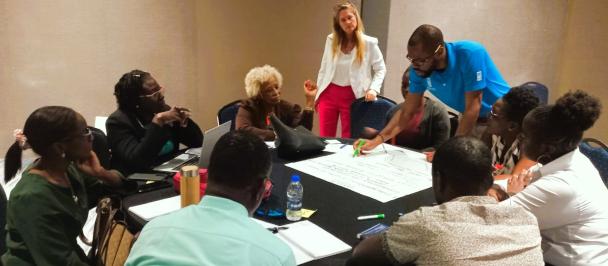Marrying the old and new through Futures Thinking: A Blue Economy Perspective
December 6, 2022
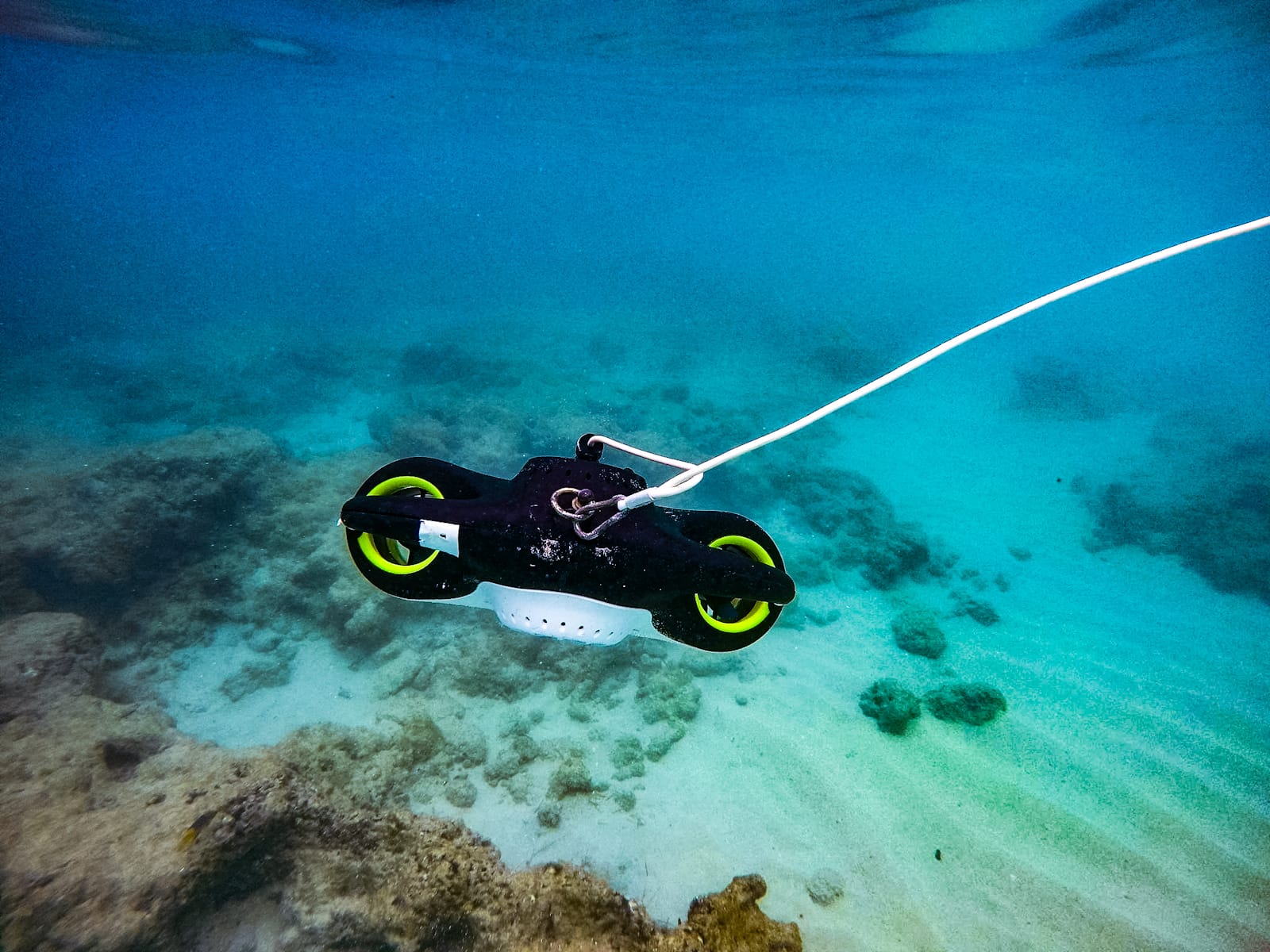
In 2018, UNDP gave itself four years to become a “next generation” organization. Now in 2022, at the four-year marker, we can see #NextGenUNDP powering progress towards the Sustainable Development Goals (SDGs), speeding up results and unlocking the potential of data to uncover solutions to pressing challenges.
As we reimagine the future of development, we must ask, “Is this enough?” No, that is not to say that our transformation is complete; UNDP is constantly changing the way we think, invest, manage and deliver as we evolve into #FutureSmartUNDP. To effectively navigate the futures (plural with an ‘s,’ but more on that later), we must prepare now, and UNDP is working with partners to create a world wherein people and planet thrive together.
What makes matters even more complex today is that we are in a period of converging crises within crises: climate, conflict, and COVID-19. Within the resulting added layers of uncertainty, complexity, and evolving risks, we are required to maintain continuity, effect change, and remain relevant. Enter the network of the Accelerator Labs, which have continued to pivot and evolve on their journey of being the world’s largest and fastest learning network.
Conceptualized in 2019 to embrace the “Next Gen” direction and contribute to the creation of a more agile, innovative environment focused on experimentation, the Labs were designed to enhance and support grassroot solutions to wicked development challenges. And the Lab network is one way in which UNDP is putting this transformative Future Smart vision and model of development into practice. Through encouraging systems transformation while sparking an innovation culture and mindset of imagination and curiosity, an innovation-based focus has become vital to enhancing relevance in the development sphere.
In this context, to address complex and systemic issues and find solutions that can meet the needs of both today and tomorrow for people and planet, we must be able to proactively anticipate what might be on the horizon. To do so, one of the key instruments in the Lab toolkit is futures and (strategic) foresight. So, what is it? Futures refers to the broader field of study that applies different approaches to thinking about the future, and the exploring of factors that could give rise to a range of possible future characteristics, events, and behaviors. Foresight is a process of conducting Futures work – anticipating and studying a range of possible futures. Strategic foresight is the anticipation and use of a range of possible futures to inform present day decision making. It pushes us to move beyond thinking in linear ways, and to think long term and systematically about disruptions. How do we practice foresight?
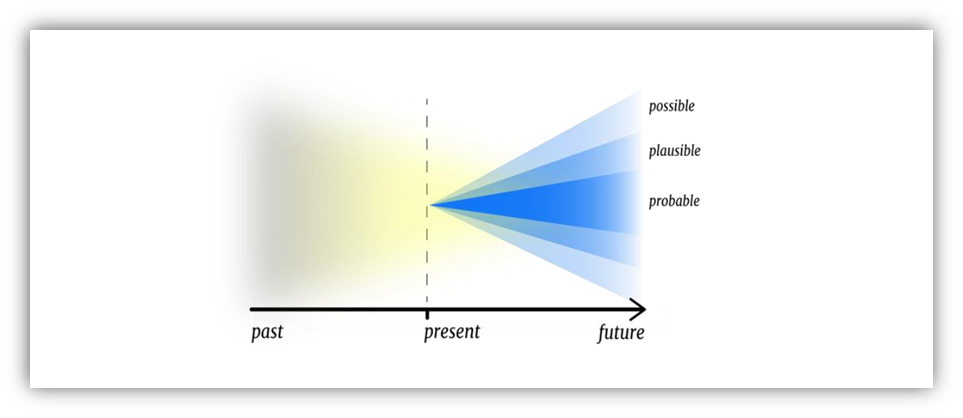
Image: UNDP Executive Office, Strategy and Futures Team
Sensing: you’re already doing it! To help explain, it is useful to reflect on some of the first things many people do within minutes of waking up: we may pick up our phone, scroll through social media channels, watch, read or listen to the news. This taking in of information helps us to notice what is changing in the world. This is a simple example of “sensing” – an intentional or undirected noticing and collection of information, data, news, or other inputs that inform awareness of the world and change within it.
One way in which sensing is done is horizon scanning – keeping track of a wide range of events, movements and shifts in addition to tuning into emerging trends or signals that can inform the dynamic picture of the present. (Think of standing on a balcony overlooking a busy road with a landscape in the distance observing everything around you, both with and without binoculars for both a zoomed in and zoomed out view). This method of observing, deep listening and tuning into the wider world around us as it unfolds is a method of futures studies and more specifically, foresight. What is arguably most essential in this practice is to detect early or weak signals of change, such as by identifying emerging threats or opportunities that are just starting to surface. Early detection allows for swift action to take place before a tipping point is reached, effectively enabling observers to have impact and awareness at critical points in time. In many cases, this can be thought of as an early warning system regarding what’s to come with potential to shape the future.
Within the Blue Economy space, we have been sensing and scanning, which has uncovered several signals and innovative future trends that are beginning to appear. These “future blue” trends include plant – based seafood, digital twins of the ocean, blue carbon, deep – sea research, new blue and green financing models and funds and marine mimicry. Once these emerging trends have been identified and examined, what comes next? Often when we are sensing, observing, and responding to new signals, it is as important to look forward as it is to look backwards. According to Smithery, there is a place between the past and the future called “the narrow now” in which we need to be as curious about the past as we are about the future, dancing delicately between what we have remembered and potentially forgotten (past) and what is shining through as possible and perhaps even preposterous (future). Both have their challenges, with “selective hindsight” and “temporal myopia” on either side of the narrow now coin.
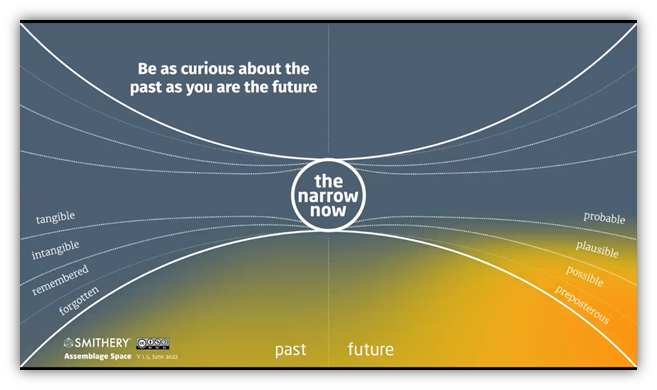
Image: Smithery Assemblage Space presentation via global Accelerator Lab Drop-In Session, 25 October, 2022
As we look to emerging blue signals, trends and futures and try to understand what is upcoming, how does this all translate at a practical level within the lives of persons on the ground, particularly in Big Ocean States (BOS) where the Blue Economy is viewed as one pathway towards economic diversification, social innovation, and resilience? Which jobs and skills may be most in demand? What does this mean for our office, our work, government, stakeholders, partners, and actors in the Blue Economy ecosystem in the Eastern Caribbean?
At the Accelerator Lab, our practice of futures thinking has frequently translated into our deep dive into the blue Future of Work (FOW) wherein we try to imagine, underpinned by signals of change, the skills and jobs that will be in demand for the next generation. Through a combination of desk research and deep listening, numerous categories of work have been mapped as critical to emerging blue jobs, including in the fields of data, Artificial Intelligence (A.I.), robotics, Research & Development (R&D), fisheries & aquaculture, renewable energy, and ports & shipping.
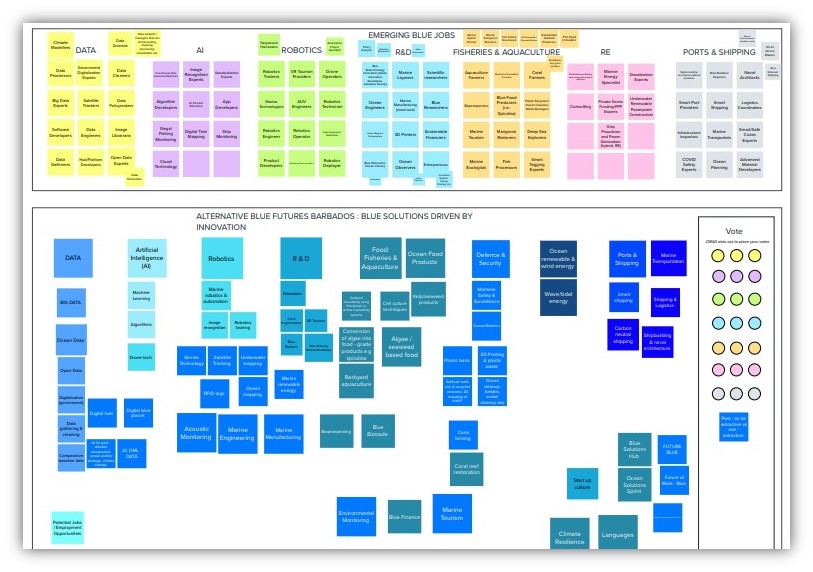
Image: Blue Futures Jobs Mural board by Nikola Simpson & Jordanna Tennebaum
While many of the job titles identified in this FOW exercise were indeed quite futuristic through robotics technicians, data harvesters and virtual reality tourism operators, it was also noted that historic and time-honored knowledge of the blue space is essential to the proper functioning of any emerging Blue Economy. To adequately move forward from the narrow now, we must ensure that we are marrying the old with the new, such as by safeguarding the historic and cultural knowledge of the ocean passed on through generations of longstanding fisherfolk. How do we best do this collectively, respectfully, and inclusively? How can we be better informed by communities to integrate social innovation, including these tools and principles, as we add value through our capabilities of being the connecting tissue between actors while also contributing our DNA to the UN mothership?
Continue to follow and join us on this journey of melding the past, present and upcoming futures together in the Blue Economy. Along our path, we encourage you to share your vision of what’s to come as we reflect, rediscover, and reimagine the way we think about futures through the lenses of imagination and innovation.
Co – written by Nikola Simpson, Head of Exploration, and Jordanna Tennebaum, Head of Solutions Mapping, with inputs from Shara Spencer.

 Locations
Locations